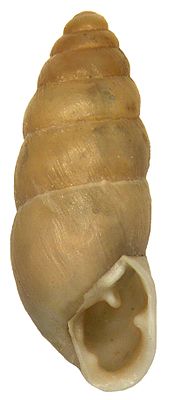Three-toothed wolverine snail
| Three-toothed wolverine snail | ||||||||||||
|---|---|---|---|---|---|---|---|---|---|---|---|---|

Three-toothed wolverine snail ( Chondrula tridens ) |
||||||||||||
| Systematics | ||||||||||||
|
||||||||||||
| Scientific name | ||||||||||||
| Chondrula tridens | ||||||||||||
| ( OV Müller , 1774) |
The Three tooth Wolverine screw ( Chondrula tridens ), and tridentate glutton worm , three dental turritellidae or three tooth turritellidae is a kind of the family of Wolverine worm (Enidae) from the subordination of terrestrial snails (gastropod).
features
The cylindrical to egg-shaped shell of the three-toothed wolverine snail is 9 to 12 mm high (rarely up to 16 mm) and 4 to 4.5 mm wide. The height of the case can vary greatly within a population with the same width. In the southeast of the distribution area the housings are larger than in the north. The housing has seven to eight turns, which are only slightly convex at the periphery. The seams between the turns are only deepened flat. The apex is conical. The mouth is crooked U-shaped and somewhat variable, especially in width. The edge of the mouth is only slightly widened and bent, but strongly thickened by a whitish lip. The points of attachment of the mouth to the previous turn are connected to one another by a weak callus. The mouth reinforcement consists of three strong main teeth, a parietal tooth, a columellar tooth and a thick palatal tooth sitting on the outer lip. Often a small angular tooth is also formed, and rarely a weak upper palatal tooth. Juvenile animals often camouflage their enclosures with debris and feces.
The case is horn-colored to red-brown in color. The surface is weakly and irregularly striped, and has a matt sheen. The shell of the case is comparatively thick-walled and only slightly translucent.
In the male tract of the genital apparatus, the few twisted vas deferens enter the comparatively short epiphallus . A worm-shaped flagellum sits at the point of entry. The small, flat-conical epiphallus caecum sits roughly in the middle of the epiphallus length. The penis and epiphallus are roughly the same length. The penis is heavily thickened at the epiphallus / penis transition. The thickness gradually decreases to about half at the confluence of the penis with the atrium. The penile caecum and penile appendix are absent. The uniform retractor muscle is attached to the proximal half of the penis (towards the epiphallus). In the female tract, the free fallopian tube (oviduct) is roughly the same length as the vagina. The spermathec is moderately long, the stem is tortuous. The bladder comes to rest roughly near the prostate. A moderately long diverticulum branches off just before the bladder.
Geographical distribution and habitat
The distribution area of the species stretches from southwest and eastern France via Switzerland and Austria through southern Europe and the northern Mediterranean to the southern Urals, Asia Minor and northern Iran. In the north there are isolated scattered occurrences as far as the Middle Rhine and Thuringia, in the east as far as Lithuania and Central Russia. In Switzerland it rises to 1500 m, in Bulgaria up to 1900 m above sea level.
The three-toothed wolverine snail lives in calcareous, warm and dry locations with little vegetation or poor grassland. It is also occasionally found in rocky locations. In the case of prolonged drought, it crawls into cracks and crevices in the ground and remains drought. They are occasionally found attached to blades of grass. The animals eat dead plant material.
Taxonomy
The taxon was first described in 1774 by Otto Friedrich Müller as Helix tridens . It is the type species of the genus Chondrula Beck, 1837.
Danger
The three-toothed wolverine snail is endangered in Germany and Switzerland.
supporting documents
literature
- Klaus Bogon: Land snails biology, ecology, biotope protection. Natur Verlag, Augsburg 1990, ISBN 3-89440-002-1 (abbreviated below, Bogon, Landschnecken with corresponding page number).
- Rosina Fechter and Gerhard Falkner: molluscs. 287 p., Mosaik-Verlag, Munich 1990 (Steinbach's Nature Guide 10), ISBN 3-570-03414-3 (p. 150)
- Ewald Frömming: Biology of the Central European Landgastropods. 404 p., Duncker & Humblot, Berlin 1954 (p. 54)
- Alexandru V. Grossu: Gastropoda Romaniae 2 Subclasa Pulmonata I Ordo Basommatophora II Ordo Stylommatophora Suprafamiliile: Succinacea, Cochlicopacea, Pupillacea. 443 S., Bucharest 1987 (pp. 312-313).
- Jürgen H. Jungbluth and Dietrich von Knore: Trivial names of land and freshwater mollusks in Germany (Gastropoda et Bivalvia). Mollusca, 26 (1): 105–156, Dresden 2008, ISSN 1864-5127 (p. 116)
- Michael P. Kerney, RAD Cameron & Jürgen H. Jungbluth: The land snails of Northern and Central Europe. 384 pp., Paul Parey, Hamburg & Berlin 1983, ISBN 3-490-17918-8 (p. 133)
- Francisco W. Welter-Schultes: European non-marine molluscs, a guide for species identification = identification book for European land and freshwater mollusks. A1-A3 S., 679 S., Q1-Q78 S., Planet Poster Ed., Göttingen 2012, ISBN 3-933922-75-5 , ISBN 978-3-933922-75-5 (hereinafter Welter-Schultes, Identification book, page number)
- Vollrath Wiese: Germany's land snails. 352 p., Quelle & Meyer, Wiebelsheim 2014, ISBN 978-3-494-01551-4 (hereinafter meadow, land snails, page number)
On-line
Individual evidence
- ↑ Bogon, Landschnecken, p. 144.
- ↑ a b Wiese, Landschnecken, p. 113
- ↑ Otto Friedrich Müller: Vermivm terrestrium et fluviatilium, seu animalium infusoriorum, helminthicorum, et testaceorum, non marinorum, succincta historia. Volume alterum. S. I-XXXVI, 1-214, Heineck & Faber, Copenhagen & Leipzig, 1774, online at www.biodiversitylibrary.org (S. 106/7)
- ↑ Welter Schultes, Identification Book, p. 178
annotation
- ↑ Jungbluth and von Knorre (2008) propose the common German name tower snail for the Enidae family, correspondingly Chondrula tridens is called a three-tooth tower snail. Since the common name tower snails is already assigned to a marine snail group ( tower snails = Turritellidae), the older name wolverine, which is used throughout the (older) literature, is used here for the family Enidae, and correspondingly the three-toothed wolverine snail for the species Chondrula tridens .